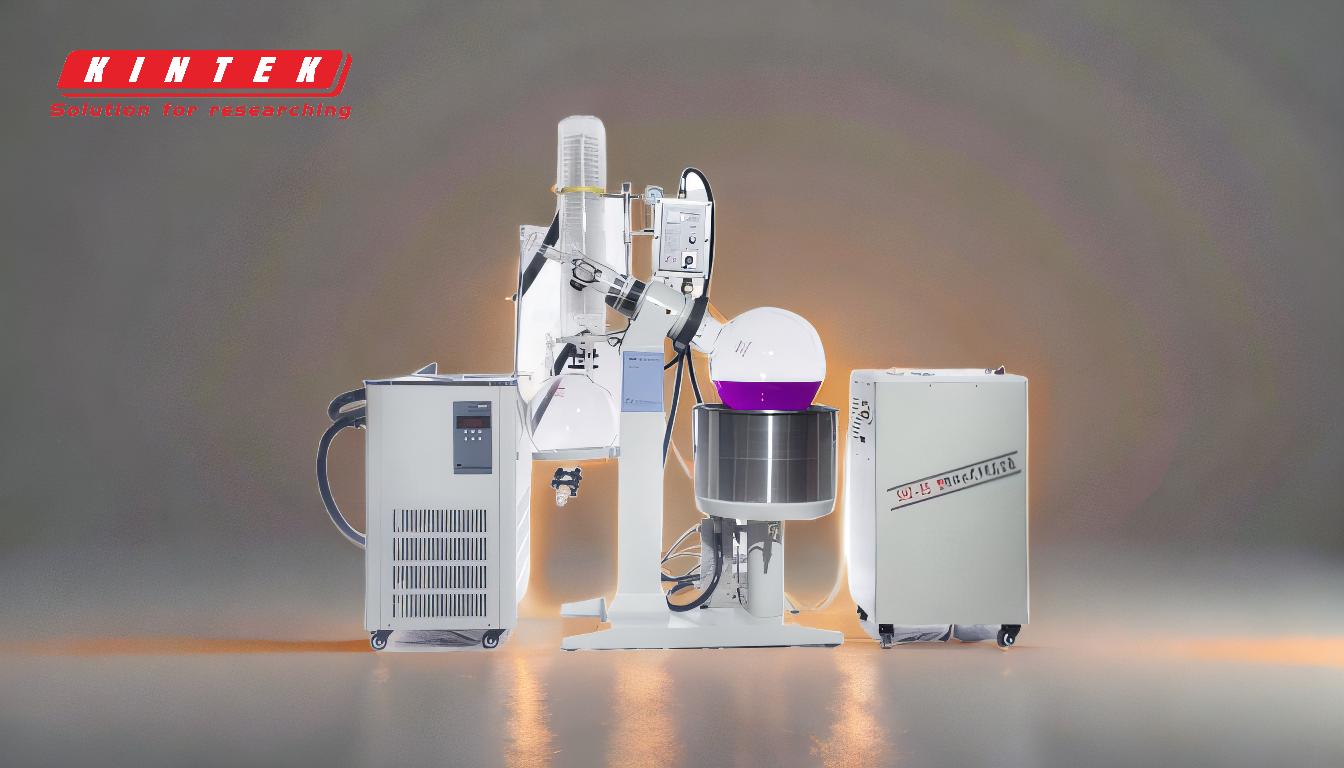A rotary evaporator, or rotovap, is a device used primarily in laboratories to efficiently and gently remove solvents from samples through evaporation. The mechanism of action revolves around the principles of reduced pressure, controlled heating, and continuous rotation of the sample flask. By lowering the pressure inside the system, the boiling point of the solvent is significantly reduced, allowing evaporation to occur at lower temperatures. The rotation of the flask creates a thin film of the sample on the inner wall, increasing the surface area for evaporation and ensuring uniform heating. The evaporated solvent is then condensed and collected in a separate flask, leaving behind the non-volatile components. This process is particularly useful for heat-sensitive materials and volatile solvents, as it minimizes thermal degradation and speeds up the distillation process.
Key Points Explained:

-
Reduced Pressure (Vacuum) System:
- The rotary evaporator operates under a vacuum, which lowers the internal pressure within the system.
- Lowering the pressure reduces the boiling point of the solvent, enabling evaporation at much lower temperatures than at atmospheric pressure.
- For example, solvents like dimethylformamide (DMF) or dimethyl sulfoxide (DMSO), which have high boiling points at normal pressure, can be distilled at 50°C under a vacuum of 5 torr.
- This is crucial for preserving the integrity of heat-sensitive compounds and preventing thermal decomposition.
-
Rotation of the Evaporation Flask:
- The evaporation flask is continuously rotated by a motorized system, typically at a controlled speed.
- Rotation creates a thin, uniform film of the sample on the inner wall of the flask.
- This thin film increases the surface area available for evaporation, significantly speeding up the process.
- The rotation also minimizes "bumping," a phenomenon where sudden boiling can cause splashing or loss of sample.
-
Controlled Heating:
- The flask is partially submerged in a heated water or oil bath, providing consistent and gentle heating.
- The heat is evenly distributed across the rotating flask, ensuring uniform evaporation of the solvent.
- The combination of reduced pressure and controlled heating allows for efficient distillation without excessive thermal stress on the sample.
-
Condensation and Collection:
- The evaporated solvent travels through a vapor duct into a condenser, typically cooled by a circulating coolant (e.g., water or refrigerant).
- The condenser cools the vapor back into a liquid state, which is then collected in a separate receiving flask.
- This step ensures the solvent is recovered efficiently and separated from the non-volatile components of the sample.
-
Vacuum Pump:
- A vacuum pump is used to maintain the reduced pressure environment throughout the process.
- The pump continuously removes air and solvent vapors from the system, ensuring consistent evaporation and preventing pressure buildup.
- The efficiency of the vacuum pump directly impacts the performance of the rotary evaporator, as it determines the achievable pressure and boiling point reduction.
-
Applications and Advantages:
- Rotary evaporators are widely used in chemistry, pharmaceuticals, and food science for solvent removal, concentration, and purification.
- The process is ideal for volatile solvents and heat-sensitive materials, as it minimizes thermal degradation.
- The combination of reduced pressure, rotation, and controlled heating makes rotary evaporation faster and more efficient than traditional distillation methods.
-
Example of Practical Use:
- For instance, in a laboratory setting, a researcher might use a rotary evaporator to remove ethanol from a plant extract. Under reduced pressure, ethanol evaporates at a lower temperature, preserving the bioactive compounds in the extract. The ethanol vapor is condensed and collected, leaving behind a concentrated extract in the evaporation flask.
By combining these principles—reduced pressure, rotation, controlled heating, and efficient condensation—the rotary evaporator provides a reliable and gentle method for solvent removal, making it an indispensable tool in modern laboratories.
Summary Table:
| Key Component | Function |
|---|---|
| Reduced Pressure System | Lowers boiling point of solvents, enabling evaporation at lower temperatures. |
| Rotation of Flask | Creates a thin film of the sample, increasing surface area for evaporation. |
| Controlled Heating | Provides uniform heating, preventing thermal degradation of samples. |
| Condensation & Collection | Condenses evaporated solvent into a liquid for recovery. |
| Vacuum Pump | Maintains reduced pressure for consistent evaporation. |
| Applications | Ideal for solvent removal, concentration, and purification in labs. |
Discover how a rotary evaporator can optimize your lab processes—contact us today!










